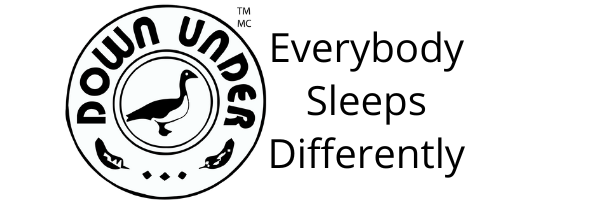What kind of filling would you like? Jelly? Caramel? Chocolate? Oh? Sorry! I got sidetracked by doughnuts! We are here to talk about Duvet fillings!
Duvet covers can come in all shapes and sizes, but never judge a book by its cover. What matters is the inside. A quick google search will quickly unveil the myriad of different options available to stuff your duvet with. No matter which crevasse of the internet you explore undoubtedly you will come to one common perception:Down & Feather duvetsare the most popular.
So, if down & feather are the most popular, why not go with one of those? Well, you certainly could! But it's never wise to settle down before looking at all your options, is it? And although they have excellent reasons to be the most popular duvets, we are here to discuss some duvet alternatives for you.
Why Is Down & Feather So Popular?
Down & feather fillings are the cool kids on the block, They both have high “fill power values” meaning they can trap large amounts of air, keeping things light, fluffy, and insulated especially Down Under Bedding's Goose Down Duvet that's so comfortable! Down & feather do indeed come from the same place normally geese or ducks. But this doesn’t mean they are the same, whilst feathers are just that—feathers, down is a protective fiber from the bellies of the birds. This allows down to be the better insulator while giving feathers an upper hand in firmness.
Now, the kicker for these fills is a bit upfront in nature. Firstly these are animal products, if you are looking for animal-friendly natural products these fillings are not for you. Secondly, since we are talking about the cream of the crop when it comes to duvet fills, we can also add a hefty price tag to that title, down & feather does not come cheap. Well, with this being said, these two options are not your only ones! Let's explore some more alternatives that are available to you:

Popular kids stand aside—The weird kids are coming.
Wool Duvet
Wool, just the thought of it makes me feel cozy and warm! It is made from the hair or fur of a variety of different types of animals, which can include sheep, goats, alpacas, llamas, camels, and rabbits(cute!).
Down Under's Natural Wool duvet is an alternative and generally sits at a more affordable price point, which makes it appealing. The hair from these animals can be made into yarn or spun, which is then woven into a material that can be used for many purposes, such as duvet filling. Most wool bedding in the USA and Canada is made from sheep's wool. Unlike many other products, wool is naturally flame resistant, which gives it another upper hand on the fabric market; safe and reliable. Since wool has a natural ability to absorb moisture, it can ‘wick’ it away. As a duvet alternative, this helps keep your body’s temperature regulated and nice. On top of all that, it is hypoallergenic too! So, no more Achoo!
Wool has many things going for it, but like most things in life; it is not perfect. If you are searching for something as a duvet alternative, then, this is not it as wool comes a certain level of heft. Although wool duvets are not as heavy as weighted blankets, they are still on the heavier side of the bedding. This is still an animal product, so if this is something that bothers you then stay away from this choice (but I promise we will talk about some animal-free duvet alternatives as well)!

Silk Duvet
Ah! Silk is so smooth, luxurious, and soft. Silk is harvested from the cocoons of silkworms, they are a hypoallergenic protein fiber. Although it is not temperature-regulating like wool, it does stop overheating by keeping you cool. This duvet is a perfect niche for those who are hot sleepers. Silk also naturally conforms around your body when you sleep, giving a nice fitted feel.
Just like this Lightweight Mulberry Silk Duvet that shares a similarity with many other natural duvets: the fact that it is hypoallergenic as well, you need not to worry about your allergies when wrapped up in silk. The allergies aren’t the only things scared of silk, dust mites and fungus also stay far away from this antifungal material!
Out of all the alternatives, silk would have to be the most expensive. Because the process of creating a silk duvet is tedious at best. The price matches that effort. Even though silk is worth the price, it's still a factor when looking for a duvet alternative. Good quality silk has a long lifespan, but the more you wash it, the shorter the lifespan gets. In addition to that, silk is also very delicate, and as such, any staining would be best removed at a dry cleaner; making this one as a high-maintenance choice!

Bamboo Duvet
This panda snack is not just food, you can also sleep in it too! Don’t worry the pandas still have more than enough!
Bamboo duvetsare soft and comfortable. The fiber spacing makes it insanely breathable, so no excess heat gets trapped in with you, nobody likes excess heat. Hypoallergenic - we’ve thrown that one around quite a lot lately, right? Well, that's the level of quality recommendations we want to give out just like a lot of other natural duvet alternatives, Bamboo is hypoallergenic as well. Just like pandas, bamboo sheets are strong! The fibers run end-to-end, making them very durable with a long lifespan. Along with that lifespan, you can expect bamboo to look new for a very long time! The non-absorbent qualities of bamboo will not absorb oils from your skin, ensuring no yellowing.
Bamboo is also expensive, with pandas being endangered you would think that bamboo would be readily available and cheap to boot, but alas that is not the case. Although, just like silk, you are paying for quality. When storing bamboo duvets, one thing to watch out for is wrinkling. Since the fibers are so long, they are more prone to being wrinkled so watch out for that!

Microfiber Duvet
Microfiber, also known as Polyester—is the only duvet alternative we are listing that does not come from nature. But synthetic does not always mean bad! This duvet alternative is usually made from a synthetic blend of polyester, nylon, and sometimes even wood pulp!
As mentioned, the bamboo’s long fibers make it prone to wrinkling, but these synthetic fibers are shorter in nature, so wrinkling won’t be a problem! This duvet alternative is also low maintenance, and machine wash. You got it! Synthetic, plastic, these words are often associated with lightweight, which this alternative is, as light as feathers (minus the feathers of course!). You will be able to breathe easily knowing that this product is animal free since everything is synthetic.
Now, the microfiber duvet alternative is not without its faults, firstly synthetic fibers are highly absorbent (think of sponge) which can make it stain, and smell easily (luckily you can chuck them into the machine).
Now, this one might be a shocker, but this duvet alternative has a high chance of generating static, ouch. Again, this product is not found in nature as such the quality is highly dependent on the materials and care used by the manufacturer, do your research and buy with care.

Verdict: Which Duvet Alternative Is The Best?
One 2017 study found that during sleep, the body is sensitive to variations in ambient temperature. An individual's sleep quality may suffer if their room is moderately hot or cold. There are benefits and disadvantages out of these alternatives. To help you choose, here's a quick run down of these pros and downsides.
Now, which alternative duvet is best for you? Well, don’t let anybody tell you what to do, the answer depends on what you need. Don’t mind forking out extra cash for luxury? Go with the silk duvet. Want something with a little more heft and temperature regulation? Wool is for you. Your animal-free choices are Bamboo and Microfiber, with the Bamboo being the more quality option whilst Microfibers are your budget-friendly synthetic option. Regardless of whichever you choose, you can sleep underneath your duvet in comfort knowing that you made the best decision you could with the information you obtained from Down Under Bedding.









Paige
November 19, 2025
I am looking for a duvet that does not ball/lump up. I paid good money for a micro fiber duvet and it looks awful. Started lumping almost immediately. I tried shaking from all four sides, throwing in low dryer with dryer balls and none of it has worked.